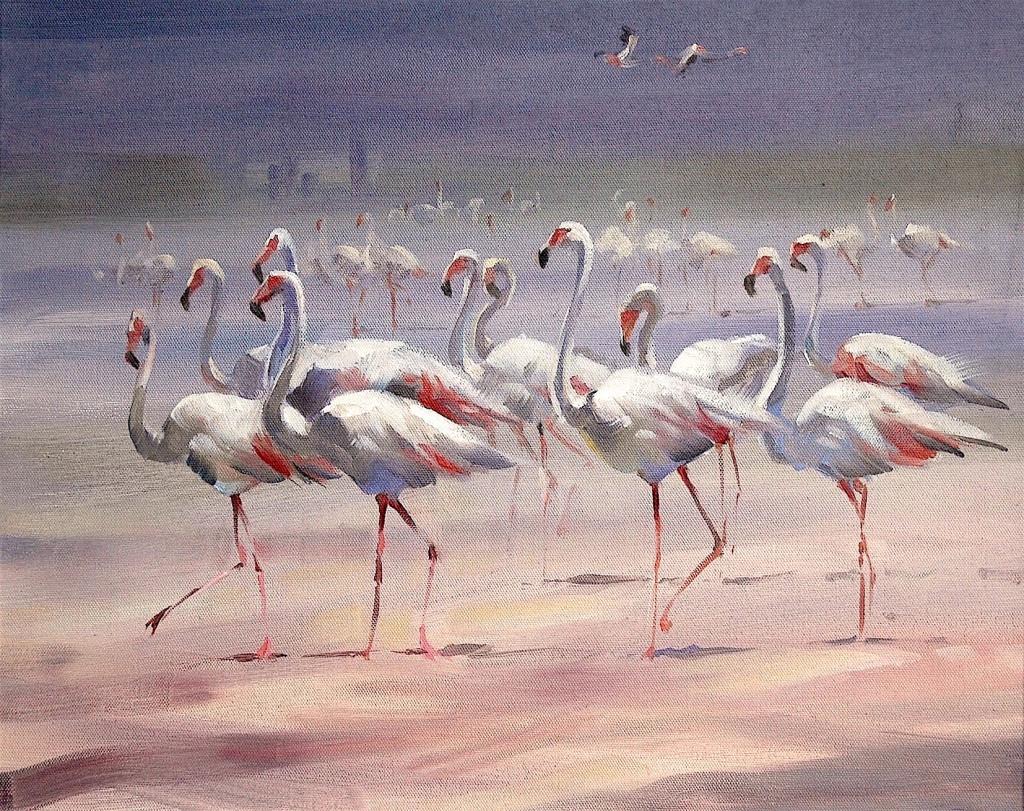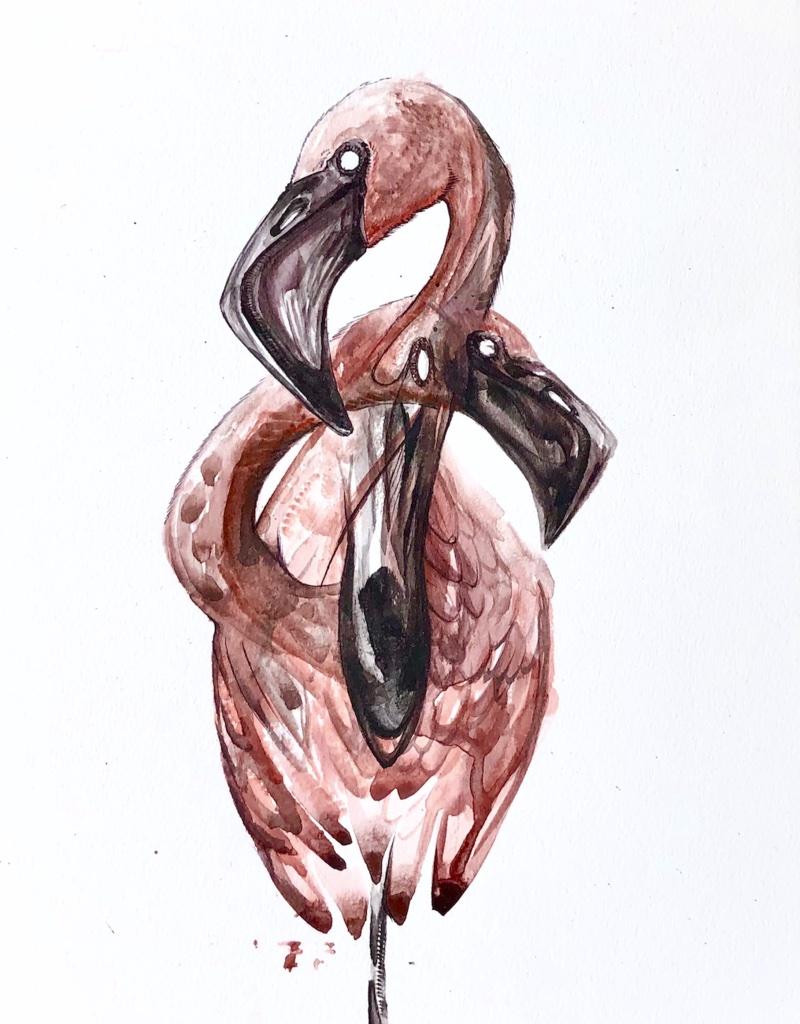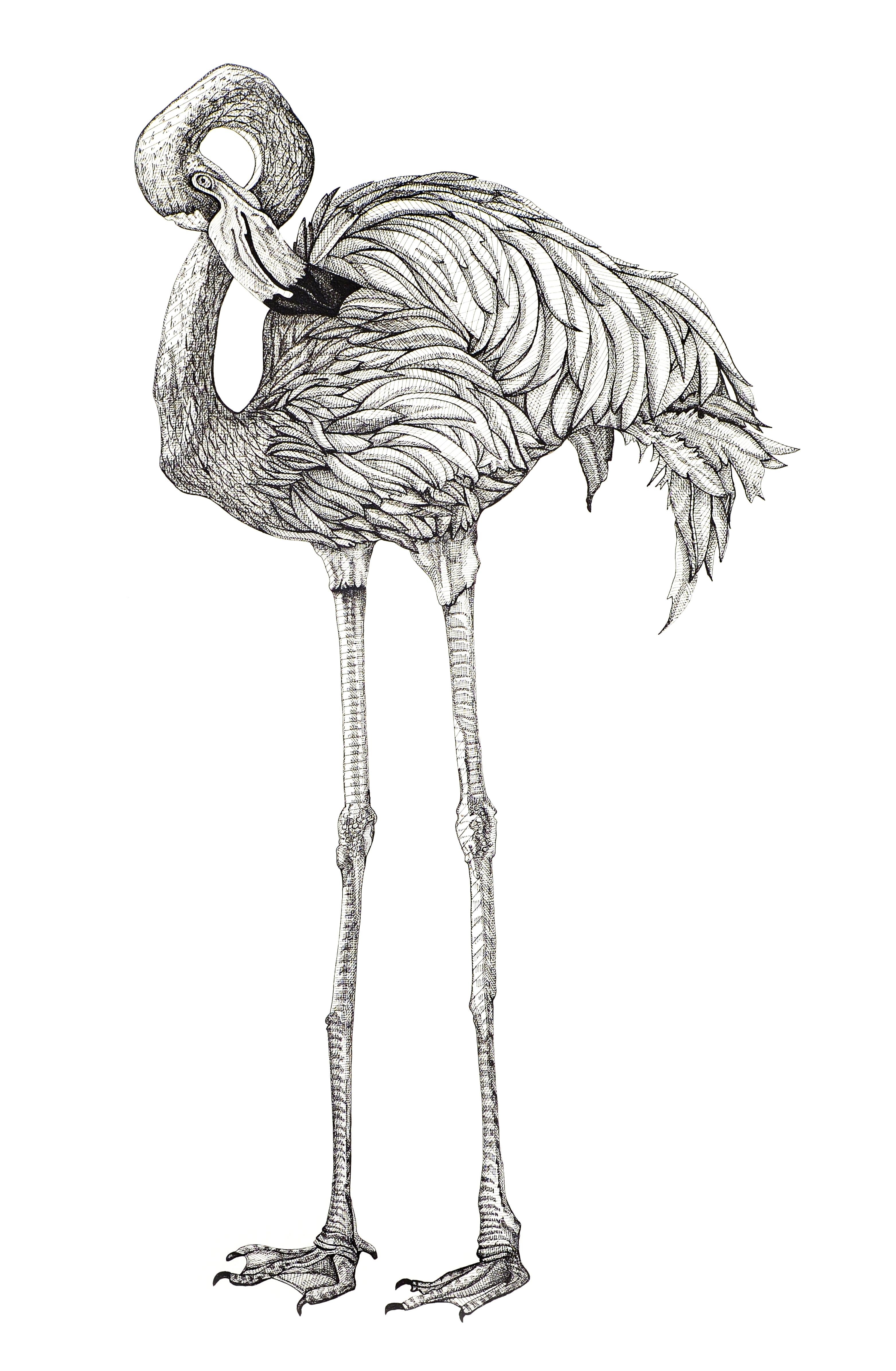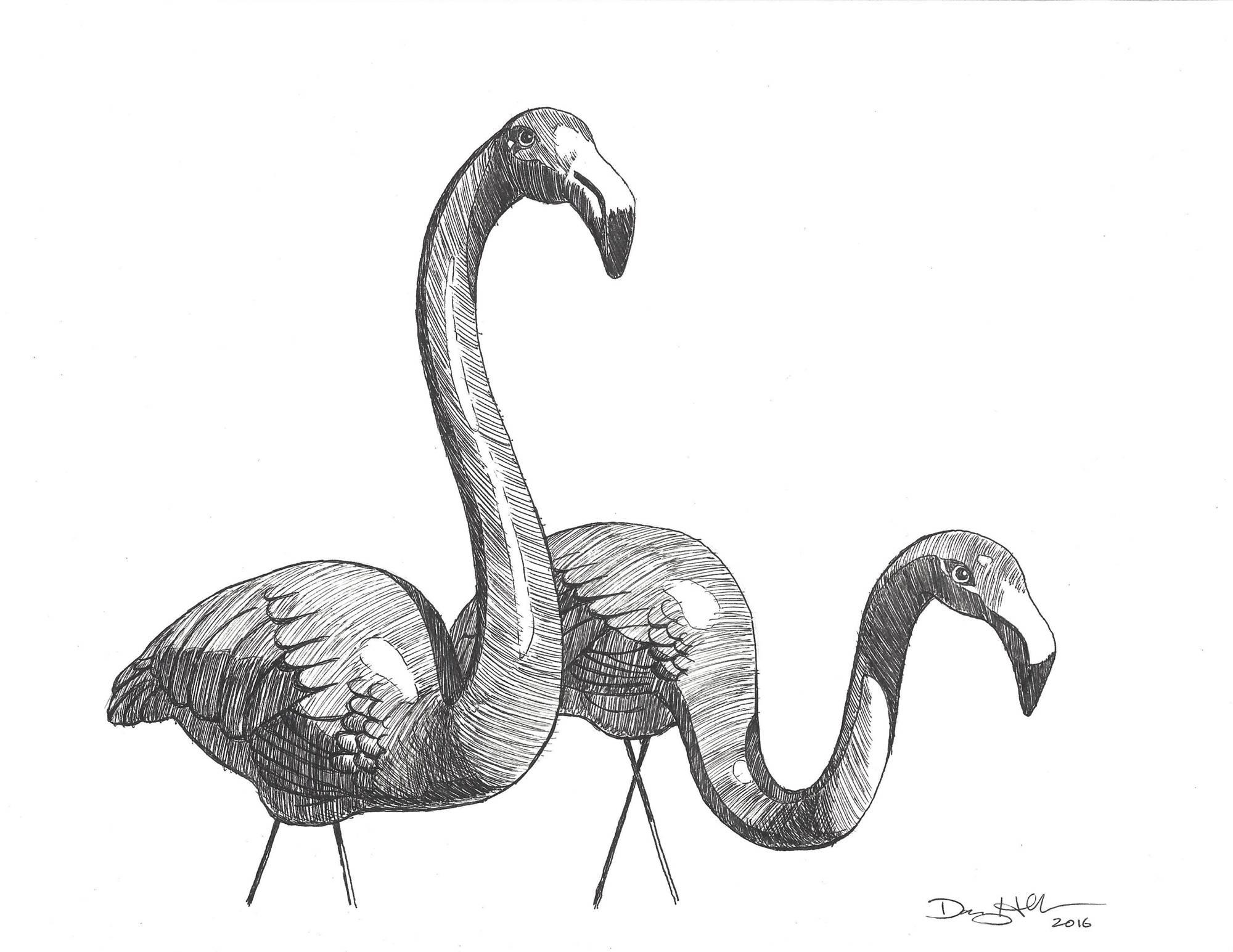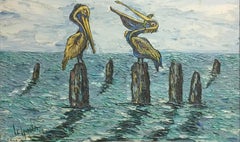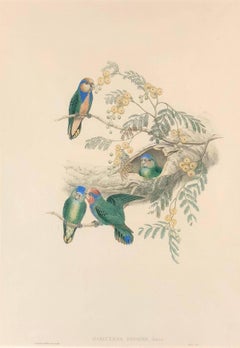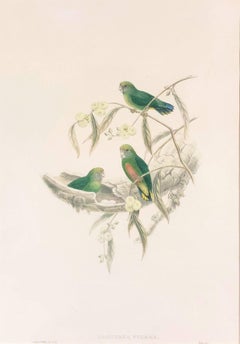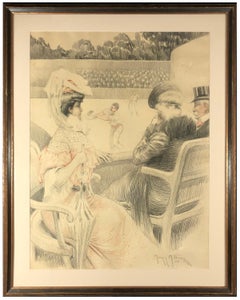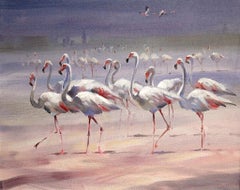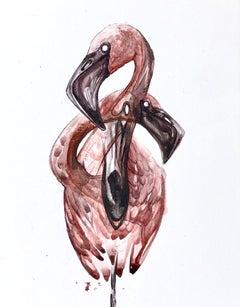Items Similar to Flamingos
Video Loading
Want more images or videos?
Request additional images or videos from the seller
1 of 8
William R. LeighFlamingos
Price Upon Request
Price Upon Request
Price Upon Request
Price Upon Request
Price Upon Request
Price Upon Request
Price Upon Request
Price Upon Request
Price Upon Request
Price Upon Request
About the Item
Flamingos
By William Robinson Leigh (1866-1955)
Signed Lower Left
Unframed: 12" x 10"
Framed: 21" x 17.5"
Born near Falling Waters, West Virginia on a plantation a year after the Civil War, and raised in Baltimore, William Leigh became one of the foremost painters of the American West with a career of seventy-five years. Some people referred to him as the "Sagebrush Rembrandt".
He was the son of impoverished Southern aristocrats and took his first art training at age 14 from Hugh Newell (1830-1915) at the Maryland Institute where he was regarded as one of the best students in his class. From 1883 to 1895, he studied in Europe, mainly at the Royal Academy in Munich with Ludwig Loefftz. From 1891 to 1896, he painted six cycloramas or murals in the round, a giant German panorama.
In 1896, he began working as a magazine illustrator in New York City for Scribner's and Collier's Weekly Magazine, and he also painted portraits, landscapes, and genre scenes. However, he was not a very successful artist in those years in New York.
Trips to the Southwest began in 1906 when he made an agreement with William Simpson, Santa Fe Railway advertising manager, to paint the Grand Canyon in exchange for free transportation West. In 1907, he completed his Grand Canyon painting, which led to many more commissions and an extensive painting trip through Arizona and New Mexico. These travels inspired him to paint western subjects for the next 50 years, but it was not until the 1940s that he received much recognition. He painted in the Southwest nearly every summer between 1912 and 1926 and focused on the Hopi and Navajo Indians.
In 1910, he traveled to Wyoming, where he painted in Yellowstone Park and did sketches, many which he later converted into large canvases such as Lower Falls of the Yellowstone (1915) and Grand Canyon of the Yellowstone (1911).
His style was realistic, and his palette invariably had the Southwestern hues of soft pinks, reds, yellows and purples. In fact, his critics who knew little of the Southwest accused him of fabricating the colors.
As an older man he was described as a big, powerful man with gray hair and a white handlebar mustache and a deep base voice. He was highly opinionated and absolutely hated modern, abstract art. During the latter part of his career, he painted a series of American historical murals as well as paintings based on his travels to Africa funded by the Eastman Kodak Company and the American Museum of Natural History in New York. For many years, his work was handled exclusively in New York at the Grand Central Art Galleries at the Biltmore Hotel.
Many of his works are at the Gilcrease Museum in Tulsa, Oklahoma. In March, 1999, the Historical Center of Cody, Wyoming held an exhibition of his field sketches and finished works depicting his experiences near Cody, Wyoming in the early part of the century, between 1910 and 1921. These years, many which he spent painting in the Carter Mountain vicinity, were considered crucial to his artistic development because he was exposed to western landscape. His companion during these travels was Cody taxidermist Will Richard who stirred his interest in wildlife.
- Creator:William R. Leigh (1866 - 1955)
- Dimensions:Height: 12 in (30.48 cm)Width: 10 in (25.4 cm)
- Medium:
- Movement & Style:
- Period:
- Condition:
- Gallery Location:Missouri, MO
- Reference Number:1stDibs: LU747311349482
About the Seller
5.0
Vetted Professional Seller
Every seller passes strict standards for authenticity and reliability
Established in 1970
1stDibs seller since 2017
156 sales on 1stDibs
Typical response time: Several days
- ShippingRetrieving quote...Shipping from: Missouri, MO
- Return Policy
Authenticity Guarantee
In the unlikely event there’s an issue with an item’s authenticity, contact us within 1 year for a full refund. DetailsMoney-Back Guarantee
If your item is not as described, is damaged in transit, or does not arrive, contact us within 7 days for a full refund. Details24-Hour Cancellation
You have a 24-hour grace period in which to reconsider your purchase, with no questions asked.Vetted Professional Sellers
Our world-class sellers must adhere to strict standards for service and quality, maintaining the integrity of our listings.Price-Match Guarantee
If you find that a seller listed the same item for a lower price elsewhere, we’ll match it.Trusted Global Delivery
Our best-in-class carrier network provides specialized shipping options worldwide, including custom delivery.More From This Seller
View AllPelicans
Located in Missouri, MO
Pelicans by Louis Carl Hvasta (1913-1993)
Signed and Dated Lower Left
Unframed: 15" x 21"
Framed: 23.75" x 33.25"
Frame was hand made by the artist himself.
A local Californian Art...
Category
20th Century American Impressionist Animal Paintings
Materials
Oil, Panel
Price Upon Request
Nasiterna Bruijni
By John Gould
Located in Missouri, MO
John Gould (British, 1804-1881)
Nasiterna Bruijni c. 1849-1861
Hand Colored Lithograph
Image Size: approx 19.5 x 13.5 inches
Framed Size: 27 3/8 x 21 1/2 inches
John Gould was an English ornithologist and bird artist. The Gould League in Australia was named after him. His identification of the birds now nicknamed "Darwin's finches" played a role in the inception of Darwin's theory of evolution by natural selection. Gould's work is referenced in Charles Darwin's book, On the Origin of Species.
Gould was born in Lyme Regis, Dorset, the son of a gardener, and the boy probably had a scanty education. Shortly afterwards his father obtained a position on an estate near Guildford, Surrey, and then in 1818 became foreman in the Royal Gardens of Windsor. He was for some time under the care of J T Aiton, of the Royal Gardens of Windsor. The young Gould started training as a gardener, being employed under his father at Windsor from 1818 to 1824, and he was subsequently a gardener at Ripley Castle in Yorkshire. He became an expert in the art of taxidermy, and in 1824 he set himself up in business in London as a taxidermist, and his skill led to him becoming the first Curator and Preserver at the museum of the Zoological Society of London in 1827.
Gould's position brought him into contact with the country's leading naturalists, and also meant that he was often the first to see new collections of birds given to the Society. In 1830 a collection of birds arrived from the Himalayas, many not previously described. Gould published these birds in A Century of Birds from the Himalaya Mountains (1830-1832). The text was by Nicholas Aylward Vigors, and the illustrations were lithographed by Gould's wife Elizabeth, daughter of Nicholas Coxen of Kent.
This work was followed by four more in the next seven years including Birds of Europe in five volumes - completed in 1837, with the text written by Gould himself, edited by his clerk Edwin Prince. Some of the illustrations were made by Edward Lear as part of his Illustrations of the Family of Psittacidae in 1832. Lear however was in financial difficulty, and he sold the entire set of lithographs to Gould. The books were published in a very large size, imperial folio, with magnificent coloured plates. Eventually 41 of these volumes were published with about 3000 plates. They appeared in parts at £3 3s. a number, subscribed for in advance, and in spite of the heavy expense of preparing the plates, Gould succeeded in making his ventures pay and in realizing a fortune. In 1838 he and his wife moved to Australia to work on the Birds of Australia and shortly after his return to England, his wife died in 1841.
When Charles Darwin presented his mammal and bird specimens collected during the second voyage of HMS Beagle to the Geological Society of London at their meeting on 4 January 1837, the bird specimens were given to Gould for identification. He set aside his paying work and at the next meeting on 10 January reported that birds from the Galápagos Islands, which Darwin had thought were blackbirds, "gross-bills" and finches were in fact "a series of ground Finches which are so peculiar" as to form "an entirely new group, containing 12 species." This story made the newspapers.
In March, Darwin met Gould again, learning that his Galápagos "wren" was another species of finch and the mockingbirds he had labeled by island were separate species rather than just varieties, with relatives on the South American mainland. Subsequently Gould advised that the smaller southern Rhea specimen that had been rescued from a Christmas dinner...
Category
1850s Naturalistic Animal Prints
Materials
Lithograph
Nasiterna Pygmae
By John Gould
Located in Missouri, MO
John Gould (British, 1804-1881)
Nasiterna Pygmae c. 1849-1861
Hand Colored Lithograph
Image Size: approx 19.5 x 13.5 inches
Framed Size: 27 3/8 x 21 1/2 inches
John Gould was an English ornithologist and bird artist. The Gould League in Australia was named after him. His identification of the birds now nicknamed "Darwin's finches" played a role in the inception of Darwin's theory of evolution by natural selection. Gould's work is referenced in Charles Darwin's book, On the Origin of Species.
Gould was born in Lyme Regis, Dorset, the son of a gardener, and the boy probably had a scanty education. Shortly afterwards his father obtained a position on an estate near Guildford, Surrey, and then in 1818 became foreman in the Royal Gardens of Windsor. He was for some time under the care of J T Aiton, of the Royal Gardens of Windsor. The young Gould started training as a gardener, being employed under his father at Windsor from 1818 to 1824, and he was subsequently a gardener at Ripley Castle in Yorkshire. He became an expert in the art of taxidermy, and in 1824 he set himself up in business in London as a taxidermist, and his skill led to him becoming the first Curator and Preserver at the museum of the Zoological Society of London in 1827.
Gould's position brought him into contact with the country's leading naturalists, and also meant that he was often the first to see new collections of birds given to the Society. In 1830 a collection of birds arrived from the Himalayas, many not previously described. Gould published these birds in A Century of Birds from the Himalaya Mountains (1830-1832). The text was by Nicholas Aylward Vigors, and the illustrations were lithographed by Gould's wife Elizabeth, daughter of Nicholas Coxen of Kent.
This work was followed by four more in the next seven years including Birds of Europe in five volumes - completed in 1837, with the text written by Gould himself, edited by his clerk Edwin Prince. Some of the illustrations were made by Edward Lear as part of his Illustrations of the Family of Psittacidae in 1832. Lear however was in financial difficulty, and he sold the entire set of lithographs to Gould. The books were published in a very large size, imperial folio, with magnificent coloured plates. Eventually 41 of these volumes were published with about 3000 plates. They appeared in parts at £3 3s. a number, subscribed for in advance, and in spite of the heavy expense of preparing the plates, Gould succeeded in making his ventures pay and in realizing a fortune. In 1838 he and his wife moved to Australia to work on the Birds of Australia and shortly after his return to England, his wife died in 1841.
When Charles Darwin presented his mammal and bird specimens collected during the second voyage of HMS Beagle to the Geological Society of London at their meeting on 4 January 1837, the bird specimens were given to Gould for identification. He set aside his paying work and at the next meeting on 10 January reported that birds from the Galápagos Islands, which Darwin had thought were blackbirds, "gross-bills" and finches were in fact "a series of ground Finches which are so peculiar" as to form "an entirely new group, containing 12 species." This story made the newspapers.
In March, Darwin met Gould again, learning that his Galápagos "wren" was another species of finch and the mockingbirds he had labeled by island were separate species rather than just varieties, with relatives on the South American mainland. Subsequently Gould advised that the smaller southern Rhea specimen that had been rescued from a Christmas dinner...
Category
Mid-19th Century Naturalistic Animal Prints
Materials
Lithograph
A Close Competition
By Maurice Milliere
Located in Missouri, MO
Maurice Milliere (1871-1946)
"A Close Competition" 1905
Colored Pencil on Paper
Signed and Dated Lower Left
Site: approx. 35 x 36 inches
Framed: approx. 43 x 35 inches
Born at Le Havre in Normandy on 12th December 1871, Millière began his art education in his home town but soon transferred to l'Ecole des Beaux-Arts in Paris, where he studied portraiture, life drawing and figure painting in the atelier of Leon Bonnat, whose pupils included Toulouse-Lautrec and Raoul Dufy. He also studied at l'Ecole des Arts Decoratifs. His skill as a draughtsman translated quickly into success as a cartoonist and illustrator and his brilliant interpretation of the "Modern Parisienne" soon became known as the "Petite femme...
Category
Early 1900s Art Nouveau Figurative Drawings and Watercolors
Materials
Paper, Color Pencil
Price Upon Request
Abstract (Edition 95/100)
By Bram Van Velde
Located in Missouri, MO
Abstract (Edition 95/100)
By Bram Van Velde (1895-1981)
Numbered Lower Left
Signed Lower Center
Unframed: 37" x 24"
Framed: 37.5" x 25.25"
Bram (Abraham Gerardus) van Velde was a Dutch painter known for an intensely colored and geometric semi-representational painting style related to Tachisme*, and Lyrical Abstraction*. He is often seen as member of the School of Paris* but his work resides somewhere between expressionism* and surrealism*, and evolved in the 1960s into an expressive abstract art. His paintings from the 1950s are similar to the contemporary work of Matisse, Picasso and the abstract expressionist Adolph Gottlieb. He was championed by a number of French-speaking writers, including Samuel Beckett and the poet André du...
Category
20th Century Abstract Abstract Prints
Materials
Lithograph
Price Upon Request
On the Lookout
By Cassilly Adams
Located in Missouri, MO
Cassilly Adams (1843-1921)
"On the Lookout" c. 1860s
Watercolor on Paper
Signed
Site Size: approx 8.5 x 14.5 inches
Framed Size: approx. 16 x 22 inches
A...
Category
Mid-19th Century Other Art Style Figurative Drawings and Watercolors
Materials
Paper, Watercolor
Price Upon Request
You May Also Like
Pink Flamingos, Watercolor Painting by Oscar Hess
By Oscar Hess
Located in Long Island City, NY
This watercolor painting was created by Oscar Hess in circa 1980. It is hand signed in the lower right hand corner, and measures 19.5 x 14 inches. It is displayed in a 27 x 22 inch m...
Category
1980s Realist Animal Drawings and Watercolors
Materials
Watercolor
Flamingoes
By Trevor Waugh
Located in Deddington, GB
Flamingoes
Trevor Waugh
Oil on canvas
Unframed
Animals
Category
2010s Realist Paintings
Materials
Canvas, Oil
Flamingo Study
By Johnathan Ball
Located in Toronto, ON
12" x 9" Unframed
Original - Ballpoint Pen and Watercolour Paint on Board
Hand Signed by Johnathan Ball
Category
21st Century and Contemporary Animal Drawings and Watercolors
Materials
Watercolor, Board, Ballpoint Pen
Tropical Landscape with Palm Trees and Flamingo, German Romantic Art, Nature Art
Located in Greven, DE
Signed Pencil Drawing by Andreas Geist, a German painter of animals and theatre sceneries.
Andreas Geist was born as the son of the painter Joseph Gei...
Category
19th Century Romantic Animal Drawings and Watercolors
Materials
Crayon, Handmade Paper
Flamingo
By Arianna Fioratti Loreto
Located in New York, NY
Signed and dated
Category
2010s Old Masters Animal Drawings and Watercolors
Materials
Paper, India Ink
Flamingo Study 2
By Danny Heller
Located in Fairfield, CT
Represented by George Billis Gallery, NY & LA -- From the artist statement, "My artwork centers on mid-century American architecture and design, once revered for its groundbreaking i...
Category
2010s American Realist Animal Drawings and Watercolors
Materials
Paper, Ink
More Ways To Browse
Large Pen And Ink Drawings
Colliers Magazine
African American Art Pen Drawing
Used Newells
Flamingo Painting
Biltmore Hotel
Grand Canyon Painting
Hopi Indian
Original Watercolor Paintings Of Animals
Birds Watercolor
Horse Drawing
Artyom Abrahamyan
Horse Watercolour
Horses Watercolors
Watercolor Horse Painting
Vintage Horse Drawings
Cat Watercolor Painting
Dog Watercolor Paintings
